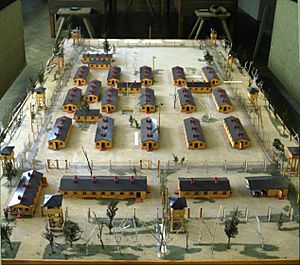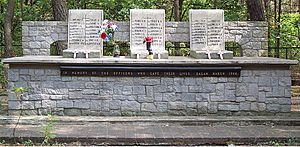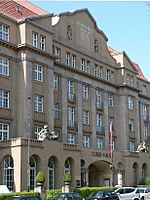Stalag Luft III murders facts for kids
The Stalag Luft III murders were terrible war crimes that happened after a famous prison break called the "Great Escape". This escape took place on March 25, 1944, from a German Air Force (called Luftwaffe) prison camp named Stalag Luft III. Many Allied prisoners of war tried to escape.
Out of 76 prisoners who successfully got out, 73 were caught again. Most were recaptured within a few days. Sadly, 50 of these recaptured airmen were killed. This was ordered personally by Adolf Hitler, the leader of Nazi Germany. These killings happened very quickly after the prisoners were caught.
People were very angry about these killings, both inside the prison camp and in the United Kingdom. In June 1944, Anthony Eden, who was the Foreign Secretary for Britain, spoke in the British Parliament. He announced that those responsible for these suspected war crimes would face "exemplary justice."
After Nazi Germany surrendered in May 1945, the Police branch of the Royal Air Force (RAF) started an investigation. The 50 airmen who were killed had been serving in the RAF. Even though German reports claimed the airmen were shot while trying to escape again, the RAF police called the shootings a war crime. Wing Commander Wilfred Bowes and Squadron Leader Frank McKenna led a big investigation by the Special Investigation Branch. This investigation was special because it was the only major war crime looked into by just one branch of a country's military.
Contents
The Killings
The day after the big escape from Stalag Luft III, Hitler first ordered that every recaptured officer should be shot. However, some top German leaders, like Reichsmarschall Hermann Göring (head of the Luftwaffe), Reichsführer-SS Heinrich Himmler (chief of state security), and Field Marshal Wilhelm Keitel (head of the German High Command), argued about who was responsible for the escape.
Göring told Hitler that killing so many prisoners might lead to other countries killing German pilots they had captured. Hitler agreed, but he still insisted that "more than half" of the escapees should be shot. He eventually ordered Himmler to kill more than half. Himmler decided on the number 50. Keitel then ordered that the bodies of the killed officers be burned (cremated). Their ashes were to be sent back to the prison camp. This was meant to scare other prisoners from trying to escape. Himmler arranged how the killings would happen, passing orders down to his officers in the Gestapo (the secret police). The general plan was that recaptured officers would be given to the Criminal Police, and then 50 of them would be handed over to the Gestapo to be killed.
As the prisoners were caught, they were questioned. Then, they were taken away by car, usually in small groups of two. The Gestapo officers would pretend to take them back to the prison camp. They would stop in the countryside and tell the prisoners they could go to the bathroom. Then, the prisoners were shot from behind at close range with pistols or machine pistols. Their bodies were left there to be picked up. After that, they were cremated, and their ashes were returned to Stalag Luft III.
The British military found out about these terrible events even during the war. They learned from letters sent home by prisoners and from Switzerland. Switzerland was a neutral country that reported on conditions in prison camps. On July 23, 1944, notices were put up in Allied prisoner camps saying, "THE ESCAPE FROM PRISON CAMPS IS NO LONGER A SPORT." This, along with the suspicious deaths of 50 officers, made the British government suspect a war crime had happened.
The British government first heard about 47 deaths in May, after Swiss officials visited the camp. Foreign Secretary Anthony Eden told the Parliament on May 19, 1944. Soon after, the senior British officer at the camp, Group Captain Herbert Massey, returned to England because he was ill. He told the government what really happened. With this information and the official German notice of 50 deaths, Eden updated Parliament on June 23. He promised that after the war, those responsible would be brought to justice.
The Victims
The Investigation
A team from the Special Investigation Branch of the Royal Air Force Police, led by Wing Commander Wilfred Bowes, was given the job of finding the people who killed the 50 officers. The investigation started 17 months after the crimes. This made it a "cold case," meaning it was old and hard to solve. It was even harder because the people who did the killings belonged to the Gestapo. The Gestapo had ways to give its members fake names and papers. They were ordered to disappear when Germany surrendered.
The small team of investigators, with 5 officers and 14 non-commissioned officers (NCOs), worked for three years. They identified 72 men who were guilty of murder or planning the murders. They found 69 of these men.
Even though people tried to hide the murders during the war, the investigators had help. Germany kept very detailed records, even at places where bodies were cremated. Many people who saw what happened were willing to tell their stories. Also, many Gestapo members confessed, saying they were just following orders.
Those Accused
Some of the most important people accused of being involved in the murders included high-ranking German officials and leaders of the Gestapo. Many faced trials after the war.
High Command Leaders
| Name | Position | Outcome |
|---|---|---|
| Hitler, Adolf | Leader of Germany | Died on April 30, 1945 |
| Keitel, Wilhelm | Head of German Armed Forces | Executed on October 16, 1946 |
| Himmler, Heinrich | Chief of German Police | Died on May 23, 1945 |
| Göring, Hermann | Head of Luftwaffe | Died on October 15, 1946 |
Gestapo Leaders
| Name | Position | Outcome |
|---|---|---|
| Kaltenbrunner, Ernst | Chief of RSHA (main security office) | Executed on October 16, 1946 |
| Nebe, Arthur | Chief of Criminal Police | Executed on March 21, 1945 (for other reasons) |
| Müller, Heinrich | Chief of Gestapo | Vanished after April 1945 |
The Trials
SS-Gruppenführer Arthur Nebe, who is thought to have chosen which airmen would be shot, was later executed by the Nazis themselves for his part in a plot to kill Hitler.
At the Nuremberg trials, which were for the most important Nazi war criminals, the murder of the 50 airmen was one of the crimes discussed. David Maxwell Fyfe, the main British prosecutor, showed that Hermann Göring and Wilhelm Keitel were at a meeting where the decision to order the murders was made. Both men were sentenced to death for this and many other war crimes.
The first trial specifically about the Stalag Luft III murders started on July 1, 1947. It involved 18 people. The trial took place at the Curio Haus in Hamburg, Germany. All the accused said they were not guilty. After 50 days, on September 3, the decisions and sentences were given. Max Wielen was found guilty of planning the crime and sentenced to life in prison. Others were found guilty of individual murders. Some received long prison sentences, and 13 were hanged in February 1948 by British executioner Albert Pierrepoint.
A second trial began in Hamburg on October 11, 1948. Decisions were reached by November 6. However, during this time, the British Foreign Secretary, Ernest Bevin, announced that Britain would not prosecute any more war criminals after August 31, 1948.




